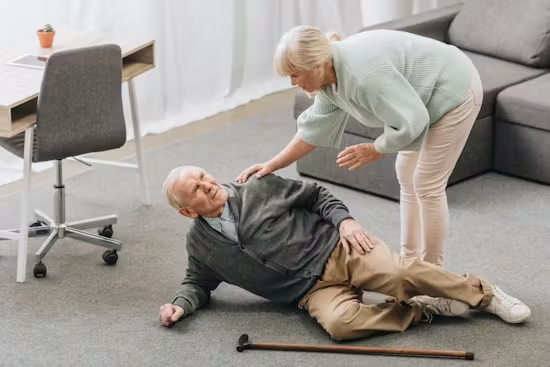A stroke is a serious medical emergency that occurs when the blood supply to a part of the brain is suddenly disrupted or decreased. This interruption or reduction in blood flow prevents the brain tissue from receiving the necessary oxygen and nutrients it requires. Being aware of the indicators of a stroke can be crucial in saving lives and greatly enhancing results. Check these 5 important warning signs of stroke.
1. Sudden Numbness or Weakness

One of the most well-known indicators of a stroke is the abrupt onset of numbness or weakness, particularly on one side of the body. This symptom can appear in different areas of the body, such as the face, arm, or leg.
Feeling Numb
- Facial Numbness: One may experience a sudden sensation of numbness or drooping on one side of the face, which is often considered a common indicator. If you happen to observe any numbness or droopiness on one side of your face, it is crucial to treat this matter with utmost seriousness.
- Encourage the individual to show a smile. If someone’s smile appears uneven or if one side of their face doesn’t move as smoothly as the other, it may indicate a potential stroke.
- Limb Numbness: Experiencing numbness in the arm or leg, especially on one side of the body, can be another sign to be aware of. This sensation can be described as a loss of feeling or a tingling sensation.
- If someone suddenly experiences difficulty lifting an arm or feels a sensation of heaviness, it should be seen as a warning sign.
Area for Improvement
- Arm and Leg Weakness: The sudden onset of weakness or paralysis in one arm or leg should not be taken lightly. Individuals experiencing this may find it challenging to lift both arms or notice one arm gradually lowering.
Likewise, a lack of strength in a single leg can lead to difficulties in walking, such as tripping or struggling to stay steady. - Coordination Challenges: Impaired coordination can also hinder the individual’s ability to carry out daily activities such as grasping objects or maintaining balance while walking.
2. Experiencing Unexpected Confusion or Difficulty with Speech

Stroke can have a profound effect on cognitive abilities, resulting in sudden confusion or difficulty with speech. This occurs when blood flow to certain areas of the brain that control language and comprehension is disrupted.
Uncertainty
- Confusion: A stroke can cause sudden confusion or disorientation in an individual. Some individuals may experience difficulty comprehending their surroundings or fail to recognize familiar individuals or locations. Making decisions or responding appropriately to inquiries may be difficult as a result of this confusion.
- Memory loss: Another indication is the inability to retain recent memories. Recalling recent events or instructions given moments earlier might prove challenging for the person.
Having difficulty expressing oneself
- Impaired Speech: Impaired or unclear speech is a common symptom of stroke. The individual may communicate in a manner that is challenging to comprehend or may experience difficulty articulating their thoughts accurately.
- Kindly request the individual to restate a straightforward sentence. If they have difficulty doing so, it may be a sign of a stroke.
- Difficulty with Verbal Communication: In certain situations, individuals may experience challenges expressing themselves verbally. They may comprehend your message, yet they might not have the ability to verbally reply.
3. Sudden Difficulty with Vision

Vision problems can be a significant indicator of a stroke. These problems can impact either one or both eyes and can arise suddenly without any prior notice.
Blurred Vision
- Impaired Vision: Vision may become suddenly blurry or be lost in one or both eyes. One may experience symptoms such as double vision, difficulty focusing, or even a total loss of vision in one eye.
- Some individuals may characterize it as a “curtain” descending over one eye or a sudden onset of darkness.
- Visual Field Loss: A Stroke can also result in a decrease in vision in a specific area of the visual field. As an illustration, individuals with this condition may have limited visual perception on one side, leading to potential collisions with objects on their other side. They may also struggle with reading or identifying faces because of their impaired vision.
Visual Perception Challenges
- Challenges with Assessing Distance: The individual may encounter difficulties with perceiving depth, resulting in challenges when it comes to estimating distances or moving around in physical environments. – Clumsiness or accidents may occur, like tripping over objects or bumping into walls.
- Experiencing Halos or Lights: Certain people may encounter the phenomenon of observing halos, flashes of light, or other visual disturbances. These symptoms can be quite disorienting and are important signs of a possible stroke.
4. Sudden, Severe Headache

A sudden and severe headache, often described as an extremely intense headache, can be a warning sign of a stroke. This is particularly true if other neurological symptoms are present along with the headache.
Characteristics of Headaches Associated with Stroke
- Intense and Unexpected: The headache usually appears suddenly and reaches its maximum intensity within minutes. It is frequently referred to as a headache that strikes suddenly and intensely.
- A stroke-related headache typically lasts longer and is more severe than a regular headache or migraine.
- Location and Nature: The pain can be focused on one side of the head or it can feel like tightness or pressure that covers the entire head. Neck stiffness, wooziness, or vomiting may accompany it.
Other Symptoms
- Dealing with Neck Pain and Stiffness: In cases where the stroke is a hemorrhagic stroke, neck pain and stiffness may also be present in addition to the headache.
- This neck pain can be incredibly intense and persistent.
- Increased Sensitivity to Light and Noise: Individuals may experience heightened sensitivity to light (photophobia) or noise (phonophobia), which can make it challenging to tolerate bright environments or loud sounds.
5. Experiencing Difficulty Walking or Loss of Balance

Stroke can impact the brain’s ability to coordinate movement and maintain balance, resulting in unexpected difficulties with walking, feelings of dizziness, or a loss of balance and coordination.
Difficulty Maintaining Balance and Coordination
- Unsteady Gait: Individuals may experience a sudden challenge in maintaining a straight walking pattern. They may exhibit unsteady movements, stumble, or display signs of intoxication even without consuming any alcohol. Having an unstable walk can lead to frequent accidents or close calls, posing a potential risk.
- Lack of coordination: The person may experience an unusual lack of coordination, frequently dropping items or struggling with fine motor skills. This lack of coordination can impact their capacity to complete basic actions such as grasping a glass of water or fastening a shirt.
Feeling lightheaded and experiencing a spinning sensation
- Unexpected lightheadedness: Unexpected lightheadedness or a feeling of spinning (vertigo) may be a sign of a stroke, especially if other symptoms like nausea or vomiting are present. Experiencing dizziness can greatly hinder one’s ability to stand up or move without help.
- Struggling with sitting or standing: It can be difficult for individuals to maintain proper posture while sitting or standing. One might experience a sensation of being pulled to one side or a loss of balance.
Understanding and Reacting to Stroke
It is crucial to understand and recognize these five important warning signs of stroke for timely intervention. If you or someone around you experiences any of these symptoms, it is crucial to take immediate action and seek emergency medical attention.
The FAST Acronym
The FAST acronym is a useful tool for remembering the important indicators of stroke and the appropriate actions to take:
- F Face: Request the individual to display a smile. Is there any drooping on one side of the face?
- A Arms: Instruct the individual to lift both arms. Does one arm sag?
- S Speech: Kindly request the individual to reiterate a straightforward expression. Does their speech sound slurred or unusual?
- Duration: If you notice any of these indicators, it is crucial to contact emergency services right away. Time is of utmost importance when it comes to stroke treatment.
The Significance of Early Intervention
- Urgent Medical Attention: A stroke is a critical medical situation that demands immediate attention. Receiving treatment promptly can greatly increase the likelihood of reducing brain damage and enhancing outcomes.
- For optimal results, it is crucial to administer treatments such as clot-busting drugs and mechanical thrombectomy shortly after the symptoms begin.
- Taking Precautions: Being aware of the warning signs is crucial for taking proactive steps to protect those who are more susceptible. Regular check-ups, effectively managing any underlying conditions like hypertension and diabetes, and adopting a healthy lifestyle are key factors in minimizing the risk of stroke.
Final Thoughts
Being aware of the indicators of a stroke can have a major impact on the outcome for the person experiencing it. If you experience sudden numbness or weakness, confusion or trouble speaking, trouble seeing, a severe headache, difficulty walking, or loss of balance, it is crucial to seek immediate medical attention. By recognizing these indicators and taking prompt action, lives can be saved, and the effects of stroke can be minimized. Stay informed, stay vigilant, and make sure you and your loved ones are ready to respond effectively to this medical emergency.